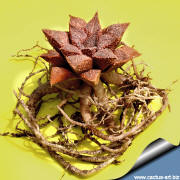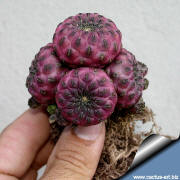| |
|
|
| |
|
Succulence
or Succulency
[ Botany ]
Adjective: Succulent
Synonym: Juicy
Adverb: Succulently |
 Dictionary of botanic
terminology Dictionary of botanic
terminology
index of names |
|
(From Latin "succulentus" [ succus = juice]
"juicy”, "moistly ")
For example: a succulent plant (such an Agave or a
Cactus) or a succulent plant part (
such as a succulent leaf,
stem or
fruit) |
Succulent
plant or
succulent
[ Botany ]
Synonym: Fat plants,
Fleshy plants, Primary stem succulents |
| |
|
|
| |
A succulent plant or succulent
is a plant that has fleshy and turgid water-storing tissues such as
stems, leaves or roots, capable of retaining large amounts of
moisture (Usually as a
drought survival strategy). |
|
| A succulent is a (usually)
nonwoody
plant ( also defined
Primary
stem succulent) that has specialized fleshy,
soft and juicy tissues designed for
the conservation of water. The
enlargement is usually due to the greater amount of the
parenchyma tissue that act as
water reservoirs.
This tissues guarantees a temporary
storage of utilizable water, which makes the plant temporarily
independent from external water supply.
The water storage tissue may be found in the
stem,
leaves, or roots depending on the
species.
Stem succulents, leaf succulents, and
root succulents are types of
growth forms. |
| |
|
|
|

(Haworthia emelyae)
Leaf and root succulence |
Classifying plants as succulent or nonsucculent
is anyway quite arbitrary , many popular books on succulents are all
vague at defining what makes a plant a succulent.
For example, a lot of popular publications on succulents often
ignore clearly succulent plants such as many orchids and bromeliads
simply because most succulent
collectors don't grow them.
A commons popular classification also differentiate the
cacti (Family:
Cactaceae) from the
“succulents” that encompass all the other succulent plants.
|

(Sulcorebutia rauschii)
Stem succulence |
Although all plants store water,
succulents are especially adapted to store water for longer periods. This allows them to survive in
arid
environments during times
of
drought and most are xerophytes
(plants preferring dry
climates, such as
cactus or sedum). But some are
halophytes (adapted for living in
salty
soils where water retention
is a problem or in coastal areas where the succulent tissue protects the
plants from the harsh salty
environment.), other are geophytes (plants
with their perennating organs
below ground, colloquially called "bulbs"
in horticulture).
In reality succulents can exist in all
climates and in
rainfall regions too. Several
succulent are also epiphytes
and come from tropical
rainforests with very high
rainfall and many succulent plants enjoy very favourable growing
climates for most of the year and only posses a succulent nature to
survive the few short months when rainfall becomes very low. |
|

(Euphorbia obesa)
Having a large internal volume for storage but minimum surface
area is also important to prevent drying up. |
During the day, the habitat of most succulent xerophytes is rather hot.
However it is cool at night when the succulents can respire. In the
morning, often the abundant dewfall of arid lands helps the plants to survive. Some succulents try
to take up as much moisture from the dew as possible by having large
surface area covered by long hair. Many succulents often have
waxy outer
layers that allow the plants to retain water well.
Having a large internal volume for storage but minimum surface area is
also important to prevent drying up. CAM photosynthesis is also a common
feature found in many succulents for water conservation. |

(Sulcorebutia gerosenilis)
The long hairs of same succulents help to take up as much
moisture from the dew |
| Succulence is a feature due to
convergent evolution
and is not necessarily an indication of genetic relationship. There are
succulents in many unrelated families. However, for some families, most
members are succulent; for example the Cactaceae, Agavaceae, Aizoaceae,
and Crassulaceae. |
|
|
|
|
|
Advertising
|
|
|
|
|
|